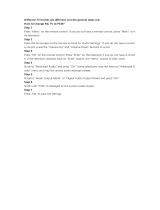
Table Of Contents
2
The Other Guides Icon ...................................................................36
Exiting A Program Guide ...............................................................37
Sorting the DIRECTV
®
Programming Guide..................................38
The Other Icons ..............................................................................42
ADJUSTING TV CONTROLS ...............................................43
Picture Quality Controls.................................................................44
Picture Settings ........................................................................44
Auto Color................................................................................45
Color Warmth ..........................................................................45
Noise Filter ...............................................................................45
Auto Converge.........................................................................45
Theatre .....................................................................................45
Reset Controls ..........................................................................45
Audio Controls ...............................................................................46
Mute .........................................................................................46
Equalizer...................................................................................46
Speakers ...................................................................................46
Special Audio ...........................................................................49
Loudness...................................................................................52
SAP............................................................................................52
Audio Language ......................................................................52
USING THE PROFILES ......................................................... 53
About Profiles.................................................................................54
The DIRECTV Setup ........................................................................54
Editing Channels in a DIRECTV List.........................................54
Selecting or Deleting All DIRECTV Channels..........................55
Setting the DIRECTV Spending Limit ......................................55
Setting the DIRECTV Rating Limit...........................................56
The TV Setup ..................................................................................57
Editing Channels in a TV List...................................................57
Selecting or Deleting All TV Channels....................................57
Setting the TV Rating.....................................................................58
The Rating Limit Screen...........................................................59
Blocking Age-Based Ratings....................................................60
Setting the Movie Rating ........................................................62
Blocking Unrated TV Shows ....................................................63
Choosing Your Profile ....................................................................64




















